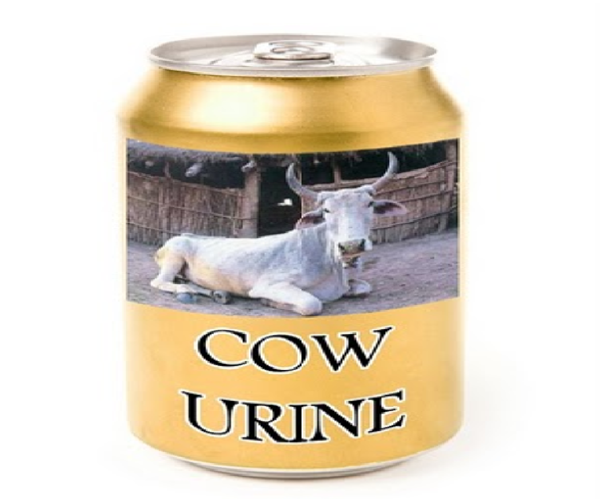My Bovine Experiences: No Beef, But Urine In Plenty
As a journalist one realises that the encounters with the bovine spirit have been many over the last two decades. And that insofar as the animal itself is concerned the right wing somehow has come to associate cow pee with hard cash.
In 2009, during an assignment with a national English daily in Uttarakhand, this reporter was told by the RSS’ cow protection department of its plans to come up with a cow urine cola to counter the popular brands in the market. The head of the department believed that such a soft drink, with the ‘magic ingredient’ of Gau Mutra as the base would capture the market instantly.
He also said at the time that products ranging from toothpaste, shampoo, soap, face powder and shaving lotion to balm, biscuits, incense sticks, phenyl, mosquito coils and distemper were being produced from cow urine and cow dung. He was happy that tiles made of cow dung have been found to be fire and water resistant and able to ward off radiation. Nuclear radiation of course! And he was determined to convert these products of cow waste into a commercial enterprise.
Just a year later, while based in Kumaon, this reporter came across a blueprint being prepared by the Uttarakhand Co-operative Dairy Federation Limited on how to extract maximum fresh cow urine to supply to various ayurvedic pharmaceutical units making Gau Ark.
The Chairman of the Federation Dr Mohan Bisht said ,” We are in the process of redesigning cattle sheds. By giving the floor of the sheds where cows are kept, a slant at a particular angle besides making a proper drain, we are looking for a mechanism to collect maximum cow urine. The drain will have layers of mesh that will help in multiple filtration of the urine.”
He claimed that the urine was being purchased by the Federation at a rate of Rs 5 per litre and was being sold to the pharmacy being run by Baba Ramdev at a rate of Rs 10 where it was being further processed into Gau Ark. The Federation was procuring 1500 litres to 2000 litres a day at that time.
Dr Bisht had disclosed that he had stumbled upon the idea of earning on a large scale from cow urine during a visit to Gujarat where he had come across a person purchasing non-milking cows at throwaway prices and had even been taking in stray cattle. The said person had told him that his daily expenditure on a single animal was Rs 50 and he was earning Rs 80 from it every day by selling the waste.
Still sometime later in 2010, Vishwa Hindu Parishad leader Pravin Togadia was seen in Rudrapur, Khatima and Haldwani promoting the manufacturing, use and marketing to products like shampoos, creams, after shave lotion and soaps etc. made from cow urine and cow dung. That was the time when the VHP seemed to have mellowed down and the differences between the outfit and Hindutva’s poster boy Narendra Modi were visible.
At a programme in Haldwani people were surprised to see Togadia going from person to person asking them to smell the “fragrance” of products made from bovine waste!
A news story this reporter had written in 2004 moves out of the superstition to hard reality insofar as bovine experiences are concerned. The venue was Limbdi town of Surendranagar in Gujarat, the state which is referred to as the laboratory of the Hindu right wing. The year was 2004. A jeweler named Mohabat Sinh Gohil had lost nearly 2,000 unpolished diamonds on his way home from work. He later realized that he had dropped the diamonds - worth more than 800 dollars near a herd of stray cattle and in all probability, a bovine had consumed it. His fears were confirmed when a cow lapped up an identical paper packet thrown before it while the other cattle heads ignored it.
He rounded up the stray cow and approached a veterinary doctor to administer laxatives. The latter refused citing medical reasons and also fearing that a cow’s death could threaten his own life. He instead asked Gohil to give green fodder to the animal and it was not long before the cow came up with sparkling dung. Gohil went on to retrieve the precious stones by diluting the cow dung and sieving it. In the process the cow owner who had abandoned the animal also turned up while government servants visited the spot to ensure that the animal was not subjected to any cruelty. Gohil had told this reporter that it would take around a month to retrieve the diamonds.
Even today, a man standing with a cow at the street corners of Gujarat near plush residential societies is a common sight. People leaving their house are supposed to shell out money on daily basis to feed the cow. Such men generally earn a few hundred every day by just moving around with the bovines.
As the Hindutva wave has caught on, another common feature is a donation box with a picture of cow on it that is visible at several shops and particularly the eating joints. So after paying for your meal and giving a tip, one is also supposed to donate something for the cow. This feature is very prominently visible in present day Gujarat and Rajasthan and catching on in the other states.





